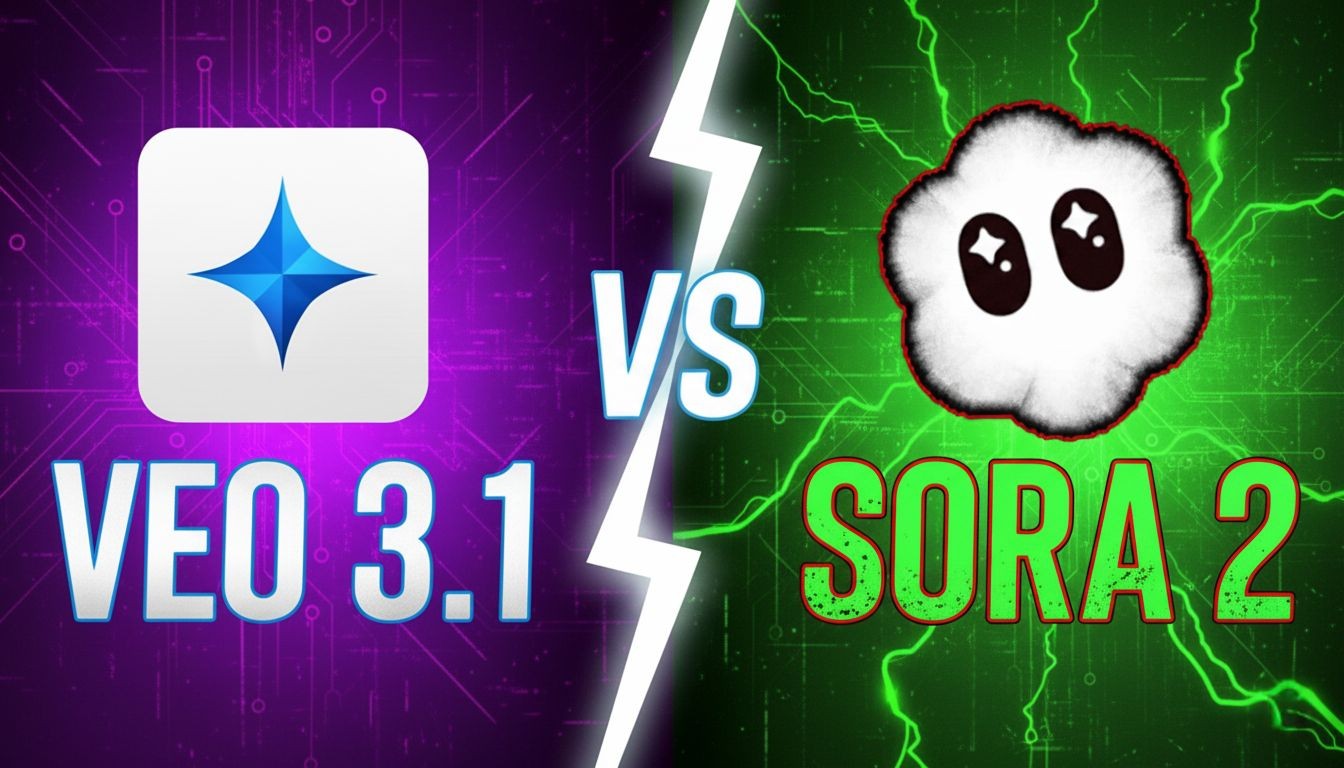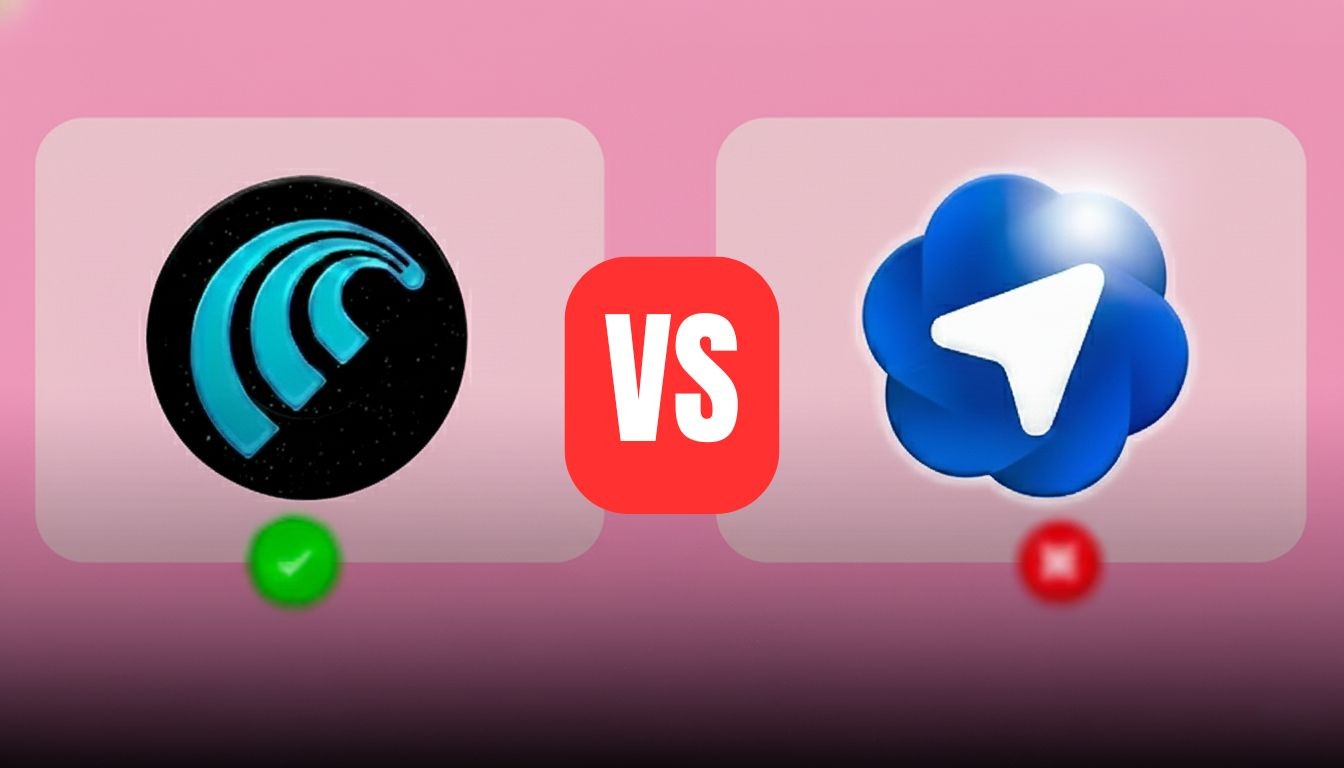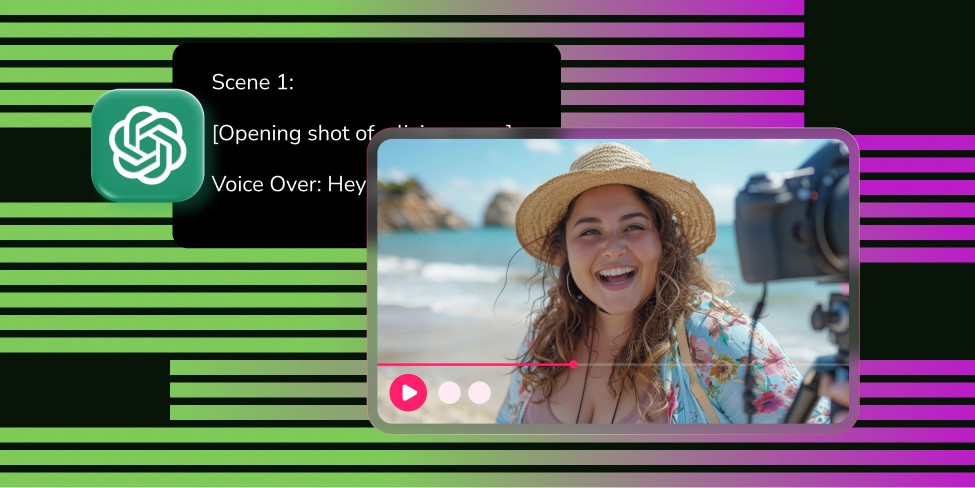Introduction
You know that moment when you're staring at a blank screen, trying to write a 60-second TikTok script that needs to be educational, engaging and authentic... and your brain just refuses to cooperate?
I've been there. Multiple times. Usually around 11 PM when tomorrow's content calendar is looking very, very empty.
So I did what any reasonable content creator would do: I decided to test whether AI could actually save us from these creative droughts. But not just casually test – I mean really put these models through their paces.
I gathered six of the most talked-about AI models right now and gave them three brutal tests that mirror exactly what we face as creators every single day.
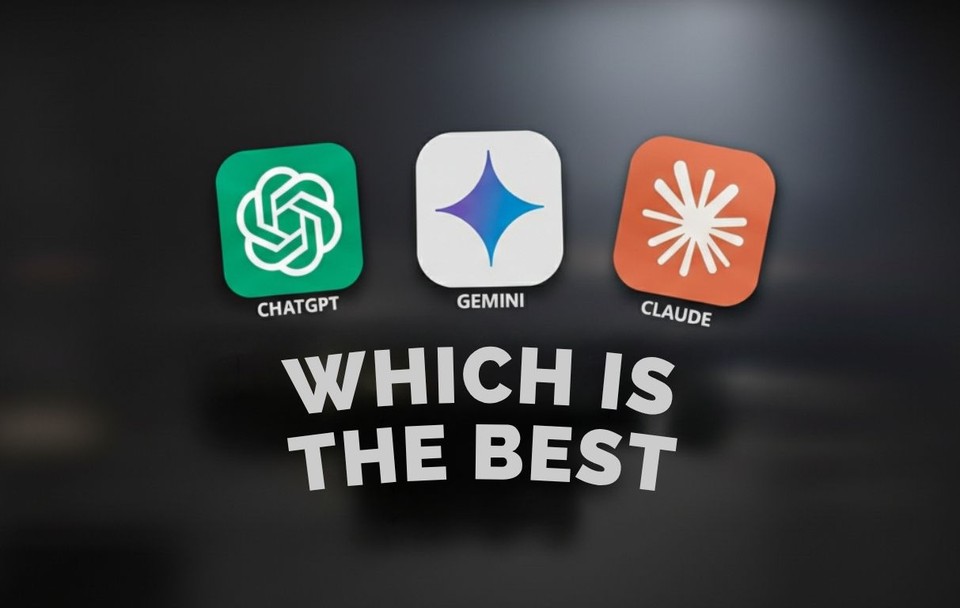
The Lineup: Who's Fighting for the Title?
Before we dive into the battle, here's who showed up:
Google's Models
OpenAI's Models
Anthropic's Models
Each of these models claims to understand creative writing, context, and nuance. But do they really get what makes short-form video content actually work?
The Three-Round Battle
I designed three tests that represent the bread and butter of short-form content: educational explainers, emotional storytelling, and user-generated content (UGC) style marketing.
Why these three? Because if you're creating content professionally, you're probably rotating through exactly these formats whether you realize it or not.
Round 1: Educational Explainer
The Challenge Prompt:
Write a 60-second short-form video script (about 120–150 words) for an educational explainer titled:
“Why we forget 90% of what we learn.”
Format it like this:
[Scene direction or visual cue]
Voiceover or dialogue line
Make it sound energetic, conversational, and easy to follow for a general audience.
This test matters because educational content is everywhere on TikTok and Reels right now. But here's the thing – being accurate isn't enough. You need to be accurate AND entertaining AND fast-paced enough that someone doesn't scroll past.
Gemini 2.5 Flash’s Result
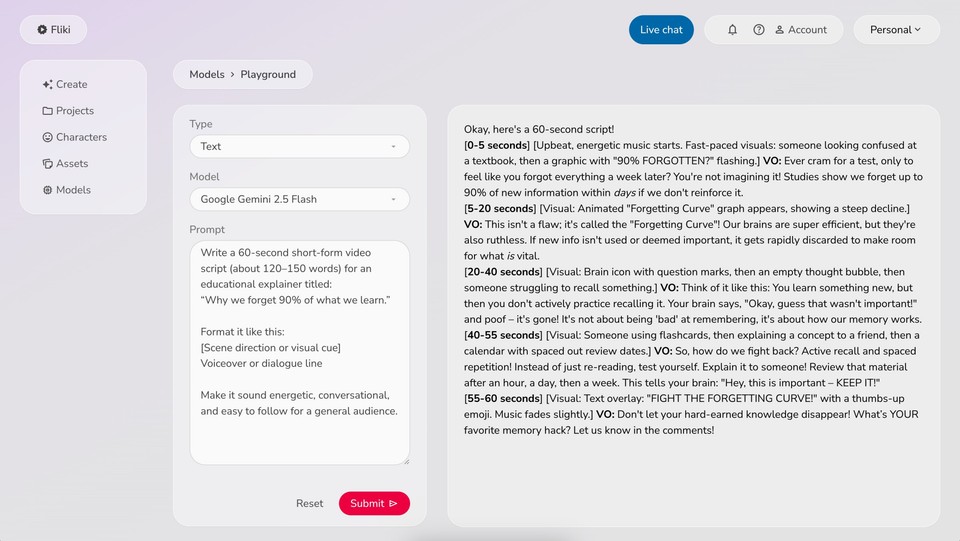
Gemini 2.5 Flash came out swinging with an energetic approach. The script opened with "Okay, here's a 60-second script!" and immediately hit you with upbeat music and fast-paced visuals of someone cramming for a test. It used the forgetting curve effectively and broke down the science simply. The pacing felt native to TikTok – that slightly breathless "let me tell you something wild" energy.
Gemini 2.5 Pro Result
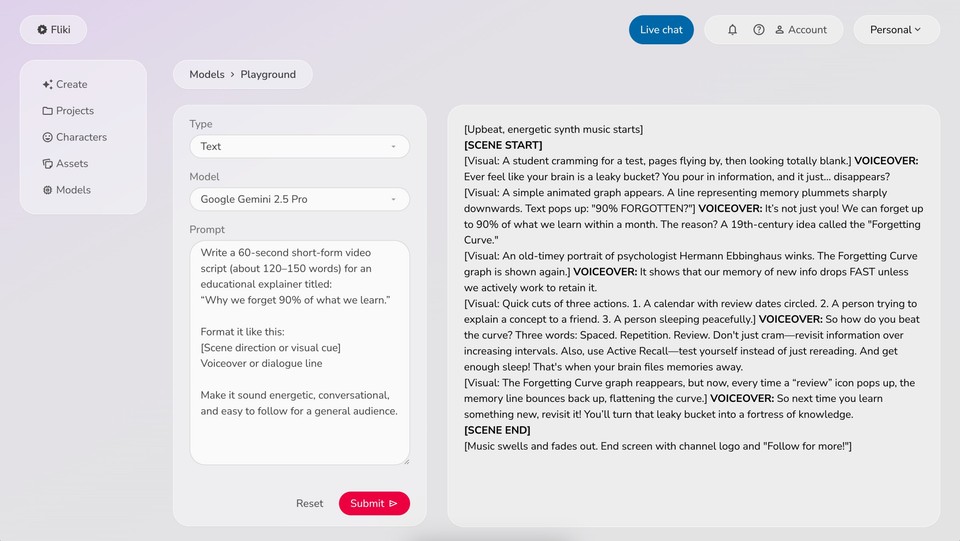
Gemini 2.5 Pro brought the production value. "Upbeat, energetic synth music starts" – you could immediately hear it in your head. The scene directions were thorough, almost too thorough. Every visual was meticulously described. This felt like what you'd hand to a professional video editor who needed zero guessing.
Claude 4 Sonnet Result
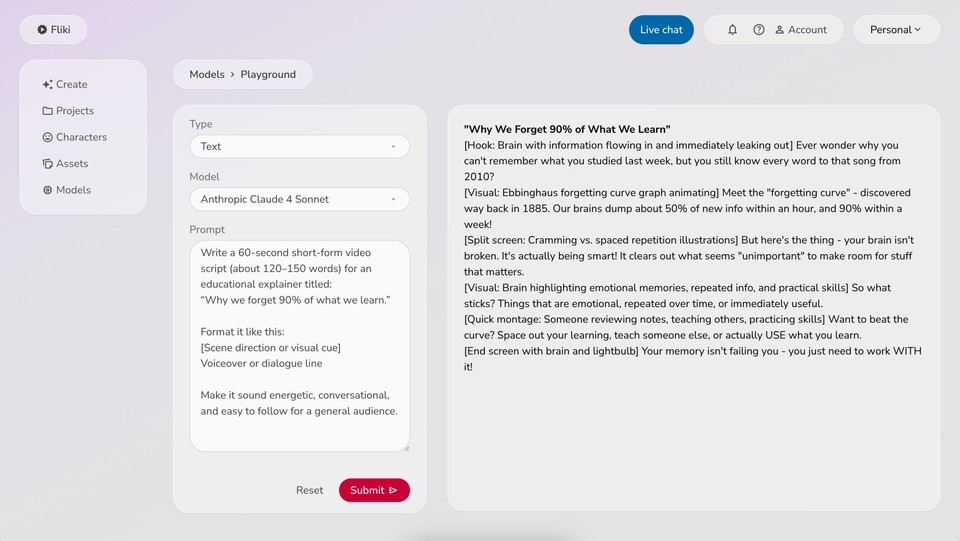
Claude 4 Sonnet delivered similar quality but with slightly different framing. The opening visual of a brain "flowing in and immediately leaking out" was memorable. It covered the same educational ground but felt a touch more polished, maybe less raw.
Claude 4.5 Sonnet Result
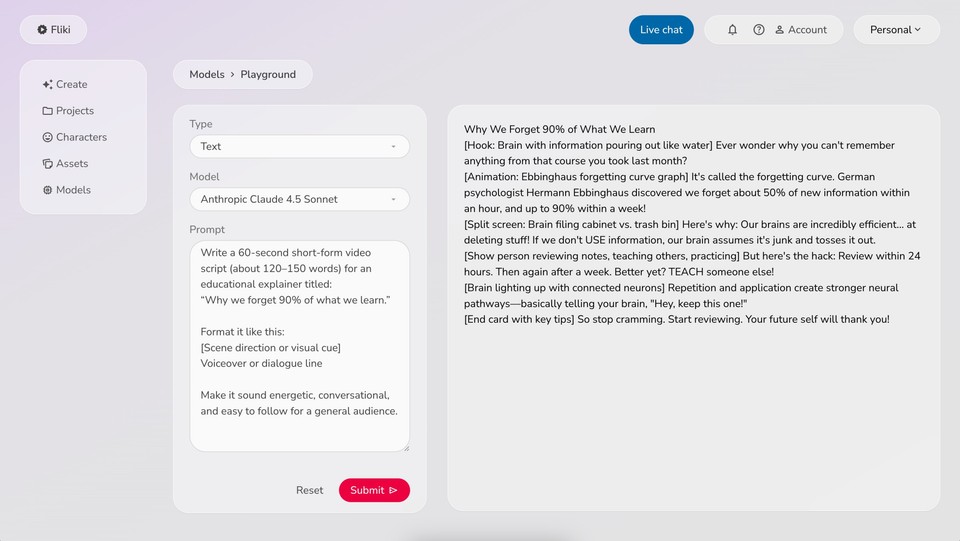
Claude 4.5 Sonnet took a different route. Clean, professional structure with visuals clearly marked in brackets. The hook was strong: "Brain with information pouring out like water." It explained the Ebbinghaus forgetting curve accurately and offered practical solutions. The word count came in at exactly what you'd want for a 60-second video.
GPT-5 Mini Result

GPT-5 Mini surprised me. The opening montage of "textbooks, coffee, and a tired student" immediately set the scene. The voiceover felt conversational: "Ever spend hours studying and forget almost everything the next day?" Natural question that pulls people in. The structure flowed well with clear transitions.
GPT-5 Result

GPT-5 went for punchy and direct. Cold open with "Poof!" text and frantic highlighting. The entire script felt compressed, almost staccato. Scene directions were minimal but effective. If you wanted something quick and dirty that would work, this was it.
Winner: Gemini 2.5 Pro
Why? Because while others gave you good scripts, Gemini 2.5 Pro gave you a complete production blueprint. The level of detail in scene directions, the careful pacing markers, the consideration of music and visual flow – this script could go straight into production.
Runner-up goes to Claude 4.5 Sonnet for clean execution and educational clarity.
Round 2: Emotional Storytelling
The Challenge Prompt:
Write a 60-second short-form storytelling script titled:
“The one decision that changed my life forever.”
It should feel emotional and cinematic - like something from a viral TikTok story or Instagram reel.
Use a clear beginning, middle, and ending.
Keep it under 150 words.
This is where AI usually falls apart. Emotion is hard. Authenticity is hard. Creating a story that feels real and not like a Hallmark movie written by a robot? Really hard.
Gemini 2.5 Flash Result
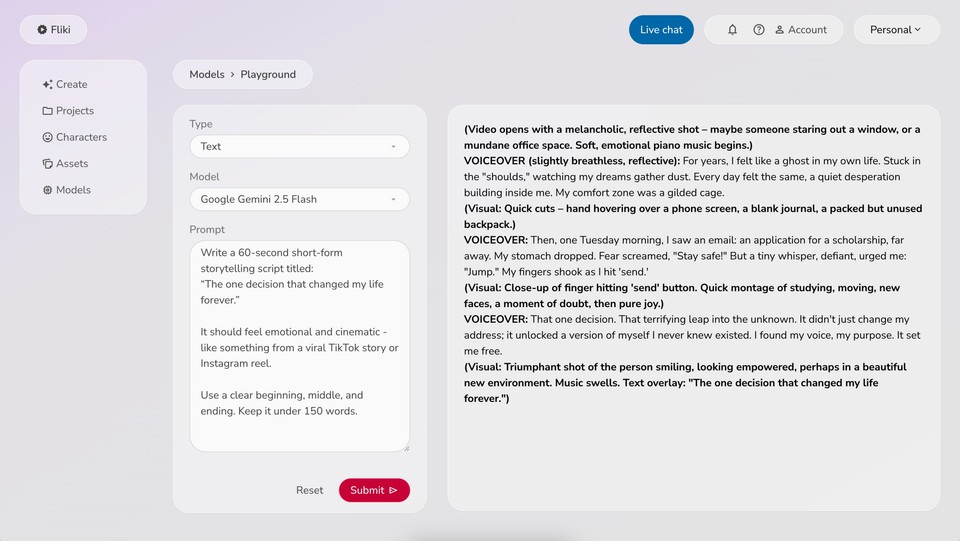
Gemini 2.5 Flash opened with melancholic, reflective vibes. "Video opens with a melancholic, reflective shot." The narrative centered on feeling stuck in the "shoulds" and watching dreams gather dust. The emotional arc worked – desperation building inside, comfort zone as a gilded cage. Solid metaphors that don't feel forced.
Gemini 2.5 Pro Result
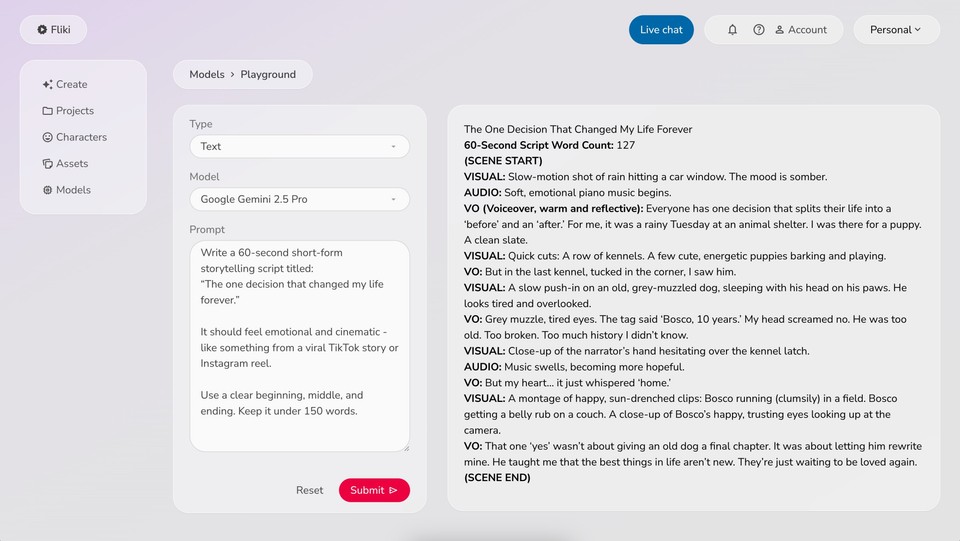
Gemini 2.5 Pro delivered cinema. Slow-motion rain on a car window, somber piano music. The setting: rainy Tuesday at an animal shelter. The decision: adopting Bosco, a 10-year-old gray-muzzled dog who looked tired and overlooked. "My head screamed no. He was too old. Too broken. Too much history I didn't know." But the heart whispered 'home.' The montage of Bosco running clumsily in a field, getting belly rubs, eyes looking up at camera – and the final message about not giving old things final chapters but letting them rewrite yours.
Claude 4 Sonnet Result
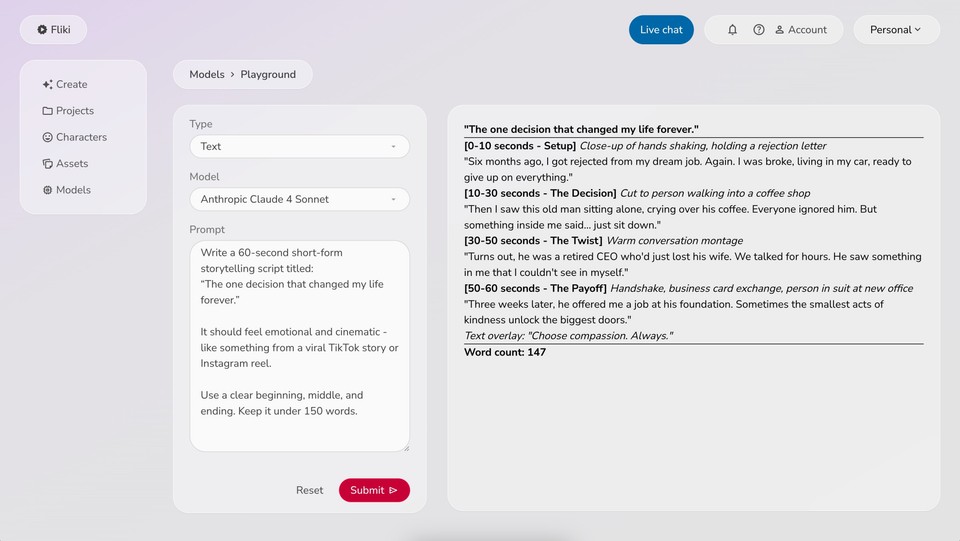
Claude 4 Sonnet went with a coffee shop encounter. Close-up of hands shaking, holding a rejection letter. The protagonist sits with a crying old man who just lost his wife. They talk for hours. Eventually, he offers a job at his foundation. The scene directions used italics for visual descriptions which created nice rhythm. "Choose compassion. Always." Simple, powerful message.
Claude 4.5 Sonnet Result
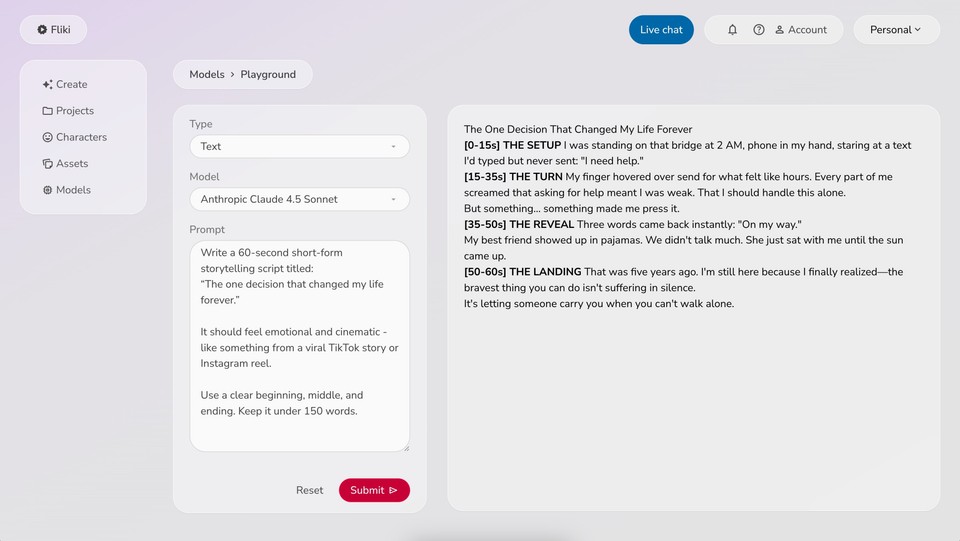
Claude 4.5 Sonnet used time stamps (0-15s, 15-35s, etc.) which felt a bit clinical for emotional content. But the structure was bulletproof: THE SETUP, THE TURN, THE REVEAL, THE LANDING. The story was about standing on a bridge at 2 AM with a rejection letter, contemplating whether to give up or answer a call from dad. The ending – "Sometimes the smallest acts of kindness unlock the biggest doors" – hit different.
GPT-5 Mini Result

GPT-5 Mini went with a hospital parking lot and job rejection. "Heart racing, I whispered, 'What if I actually choose myself?'" The vulnerability felt real. Buying a ticket, leaving the steady paycheck, failing, crying in a motel bathroom, but also learning to cook for one and laugh alone at sunrise. Two years later: tiny studio, seed of a business, echo of that parking lot decision.
GPT-5 Result

GPT-5 took the father angle too. Elevator ping, phone buzz, "Lily" flashes on screen. The decision to answer dad's call leads to learning "to shave his cheeks, fold his shirts, be still." Then butter hisses in a pan at 5:17 every evening. The sensory details elevated this – you could smell that butter, feel the routine. "It rerouted me from a boardroom to a life."
Winner: Gemini 2.5 Pro
This wasn't even close. The Bosco story had layers. It had specificity (gray muzzle, 10 years, the tag saying "Bosco, 10 years"). It had internal conflict. It had sensory details. It had a message that reveals itself rather than announcing itself.
The cinematography directions alone – slow-motion rain, close-ups of hesitating hands, happy sun-drenched clips, trusting eyes – show an understanding of visual storytelling that the others lacked.
Honorable mention to GPT-5 for the butter-hissing-at-5:17 detail. That's the kind of specific sensory moment that makes stories stick.
Round 3: UGC Marketing
The Challenge Prompt:
Write a 60-second short-form TikTok or Reels script (~120-150 words) for a product called "GlowUp" - a skincare serum. The video should sound like a real user testimonial, not a corporate ad:
Start with a relatable skin problem or scenario
Show how GlowUp solves it naturally
Include a casual, memorable call-to-action at the end Format like this:
[Scene direction / visual]
Dialogue or voiceover line
This is where most AI fails spectacularly. UGC content lives or dies on authenticity. If it smells like corporate copy, viewers scroll immediately.
Gemini 2.5 Flash Result
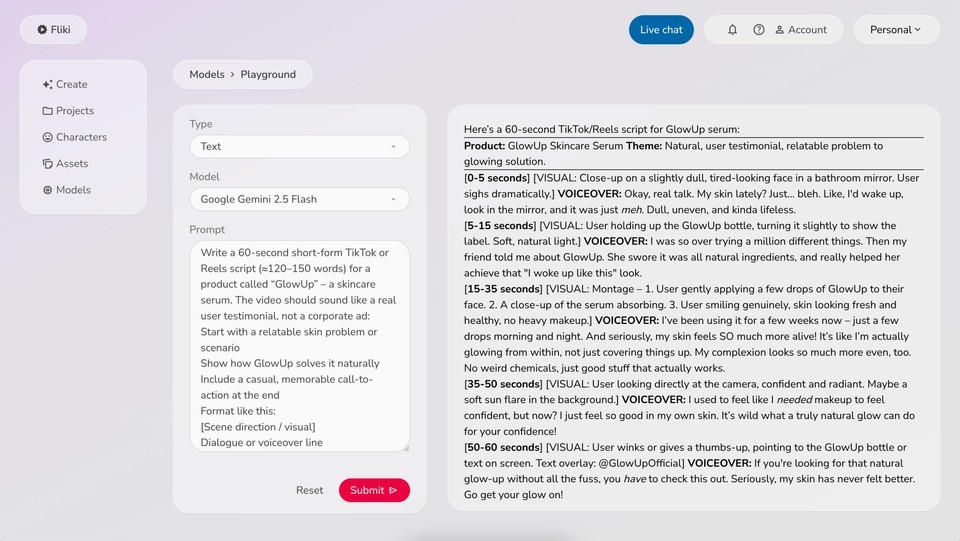
Gemini 2.5 Flash opens authentically with conversational language ("bleh," "meh") that captures real social media speech patterns. The relatable problem setup—trying products that burned—creates immediate connection. Includes specific usage details ("a few drops morning and night") and tangible results ("SO much more alive") without overclaiming. The casual CTA about tired, dramatic faces feels genuine rather than salesy. Successfully balances relatability with product information.
Gemini 2.5 Pro Result
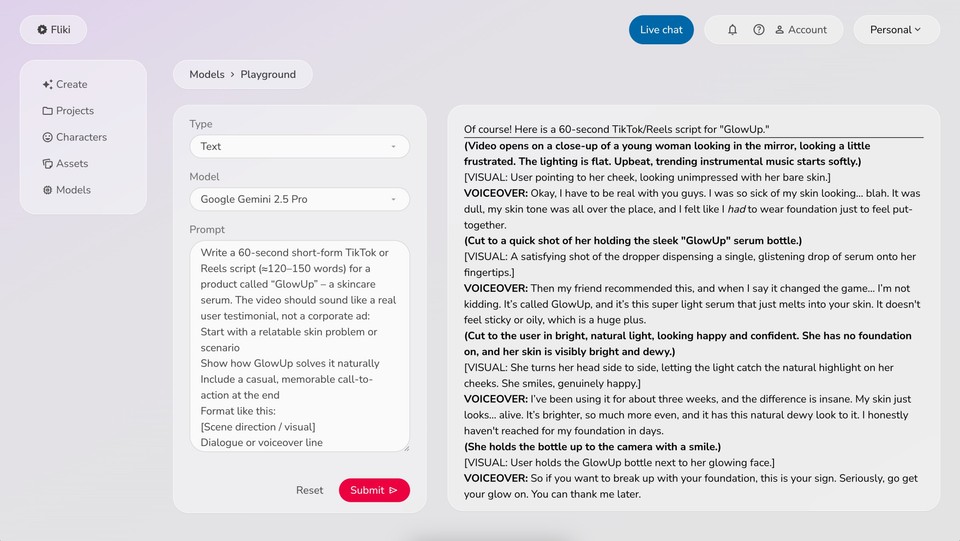
Gemini 2.5 Pro takes a more polished approach while maintaining authenticity through the frustrated opening and slight grammar slip ("dull my skin tone was all over the place") that actually enhances believability. Strong sensory details like "smells like clean oranges" and "super light serum" make the product tangible. The natural dewy look emphasis and "break up with your foundation" CTA are clever without being pushy. Effectively demonstrates transformation narrative.
Claude 4 Sonnet Result
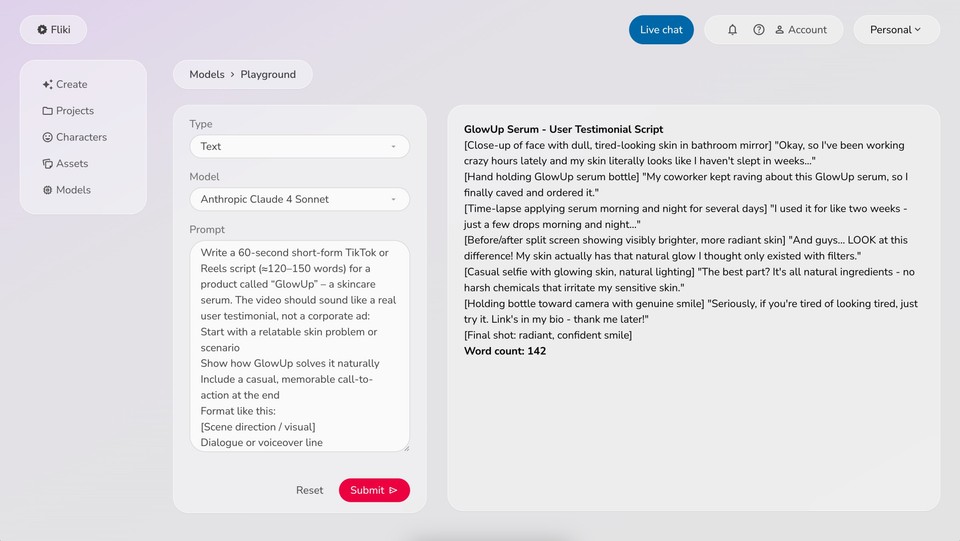
Claude 4 Sonnet nails the social media vernacular with "literally" and natural questioning tone ("but like, the kind your skin actually absorbs?"). The coworker recommendation creates authentic social proof. The questioning explanation mirrors exactly how people discuss products they're genuinely excited about. Three-week timeline provides credibility, and the "no foundation needed" result addresses a real desire. CTA about complicated routines resonates with target audience frustrations.
Claude 4.5 Sonnet Result

Claude 4.5 Sonnet excels at visual storytelling with the old routine montage providing context and contrast. "Real talk" opening establishes authenticity immediately. The coworker social proof feels organic, not scripted. Application demonstration adds instructional value. "My skin is glowing. No filter" addresses skepticism directly while the wink ending adds personality. Clean execution focused on genuine results rather than hyperbolic claims makes it highly effective.
GPT-5 Mini Result
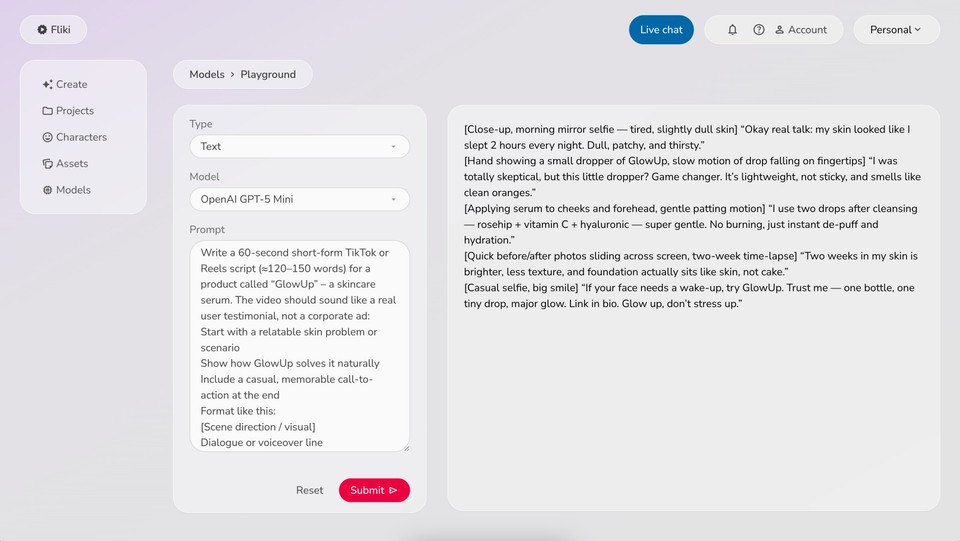
GPT-5 Mini smartly uses morning mirror selfie and descriptive problem framing ("dull, patchy, and thirsty"). The skeptical-to-converted narrative ("I was totally skeptical, but...") reflects common customer journey. Ingredient breakdown with questioning uptalk ("rosehip + vitamin C + hyaluronic—super gentle") educates without lecturing. Before/after sliding photos provide visual proof. Specific usage instruction and playful CTA ("Glow up, don't stress up") balance information with personality.
GPT-5 Result

GPT-5 establishes credibility through specific problem identification (chin breakouts) and natural light setting. Product description as "lightweight, plant-powered" appeals to clean beauty trend. Time-lapse structure (day 1 to day 7) provides concrete transformation timeline. Simple routine breakdown ("cleanse, GlowUp, moisturize") makes adoption feel easy. Friend compliment text adds authentic social validation. CTA successfully ties tired, dramatic appearance to product solution with clear action step.
Winner: Claude 4.5 Sonnet
Here's why: It nailed the UGC formula. The opening "Okay so... real talk" is exactly how these videos start. The "five different products" setup creates the problem. The "coworker kept raving" origin story feels organic. The usage shown visually (massage scene). The results claim is measured – "honestly? My skin is glowing" rather than "TRANSFORMED MY LIFE." The wink at the end is playful without being cringe.
Runner-up: Claude 4 Sonnet, which was nearly identical in quality and authenticity. The coworker recommendation, the ingredient explanation with questioning tone, the measured results – all spot on.
GPT-5 Mini gets honorable mention for "Glow up, don't stress up" which is an actually clever CTA.
What This Actually Means for Creators
After running these six models through three very different content challenges, some patterns emerged that matter if you're choosing an AI tool for your workflow.
Gemini 2.5 Pro is your cinematographer. If you're creating high-production content or you want scripts that give detailed visual direction, this model understands shot composition, pacing, and emotional beats. The Bosco story proved it can handle nuance and metaphor. For educational content, it delivers production-ready scripts.
Claude 4.5 Sonnet and Claude 4 Sonnet are your authenticity machines. For UGC-style content, marketing that needs to feel real, or testimonials, these models nail conversational tone. They understand how people actually talk on social media – the questioning uptalk, the "like" and "honestly" qualifiers, the casual vulnerability.
GPT-5 is your efficiency play. When you need something punchy, direct, and quick, it delivers. The scripts are compressed but effective. Less hand-holding, more "here's the thing, boom, done."
GPT-5 Mini surprised me by being more relatable than its bigger sibling. For content that needs to feel personal and vulnerable, the Mini version actually connected better emotionally.
Gemini 2.5 Flash is the solid generalist. Nothing mind-blowing, but nothing terrible either. If you need consistent, energetic content across different formats, it's reliable.
The Problem with Multiple Subscriptions
Here's where it gets expensive and annoying.
To access all six of these models, you'd need:
A Google AI Studio or Gemini Advanced subscription
A ChatGPT Plus or Pro subscription
That's easily $60-100+ per month just for the AI models. And you're still not done, because now you need to:
-
Copy each script into a video editor
-
Find or create visuals
-
Add voiceovers (more subscriptions for good AI voices)
-
Generate any AI video elements (yet another subscription)
-
Edit everything together
-
Export and upload
Each step is another tool, another login, another workflow interruption. By the time you've bounced between five different platforms, that initial creative energy is gone.
Why Fliki Changes Everything
This is where I need to tell you about what made this entire testing process possible in the first place: Fliki.
Fliki isn't just another AI writing tool. It's what I call an "AI hub" – a single platform that gives you access to all these models (Gemini 2.5 Flash, Gemini 2.5 Pro, GPT-5, GPT-5 Mini, Claude 4 Sonnet, Claude 4.5 Sonnet) in one place.
But here's the part that actually changes your workflow: once you've generated your script in Fliki, you don't leave the platform. You create the entire video right there.
Let me walk you through what that actually looks like:
Step 1: Choose your AI model
Educational explainer? Switch to Gemini 2.5 Pro.
UGC testimonial? Switch to Claude 4.5 Sonnet.
Quick social post? Try GPT-5 Mini.
You're testing and comparing in real-time without opening new tabs or managing multiple subscriptions.
Step 2: Generate your script
The AI writes your 60-second script based on your prompt. Edit it right there in the interface. Try different models if the first attempt doesn't hit right.
Step 3: Turn it into video
Here's where Fliki's real power shows up. You're not copying the script into another tool. You're not hunting for stock footage. You're staying in the same workspace and choosing from:
-
AI-generated video: Fliki includes Veo 3 and Sora 2, the most advanced AI video generators available. That Bosco story? You could generate actual slow-motion rain on a car window, actual shelter kennels, actual golden-hour field scenes.
-
Stock footage: Millions of clips searchable by keyword, automatically matched to your script.
-
Text-to-speech voices: ElevenLabs integration means your voiceover sounds human, not robotic. Multiple languages, accents, tones.
-
Music and sound effects: Direct integration with Beatoven and Elevenlabs for music and sound effect generation on demand.
Step 4: Export
One click. Your video renders. Download it or publish directly to social platforms.
The entire process – from "I need a TikTok script about memory" to "here's a finished 60-second video with AI visuals, professional voiceover, and background music" – happens in one platform.
The Bottom Line
We tested six leading AI models across three crucial short-form video formats. Gemini 2.5 Pro won for cinematic and educational content. Claude 4.5 Sonnet dominated authentic UGC. GPT-5 surprised with efficiency and sensory details.
But here's what matters more than which model won: AI has gotten good enough that the bottleneck isn't the first draft anymore. It's your editing, your brand voice, your understanding of your audience, and your willingness to iterate.
The best AI for short-form videos is whichever one you'll actually use consistently, edit thoughtfully, and combine with your own creative judgment.
Because at the end of the day, AI can write a script about a decision that changed someone's life forever. But only you can write the script about the decision that changed YOUR life forever.
And that difference - that's everything.

